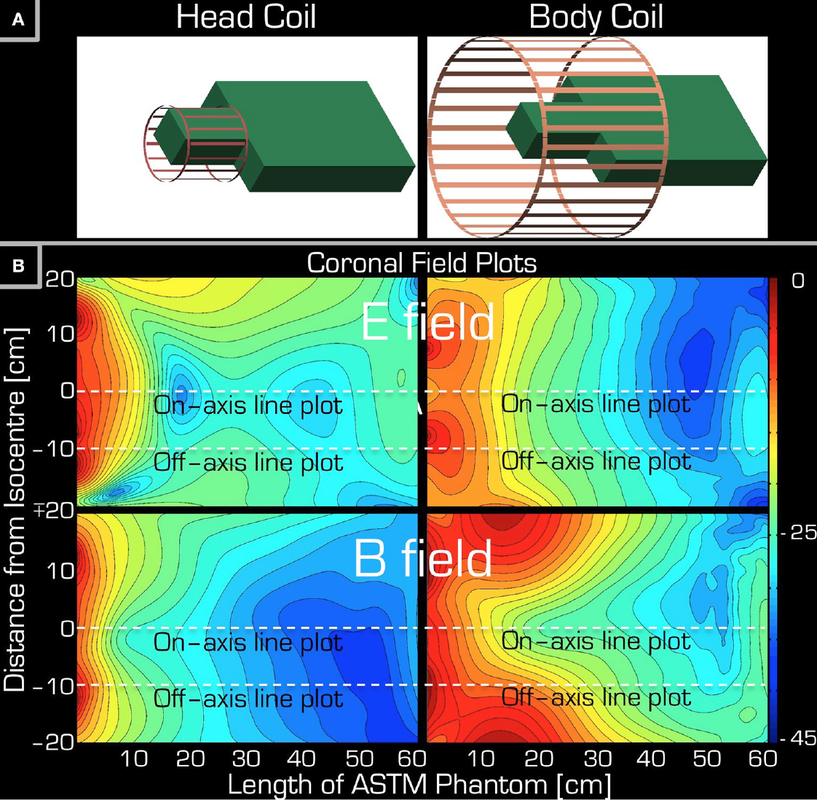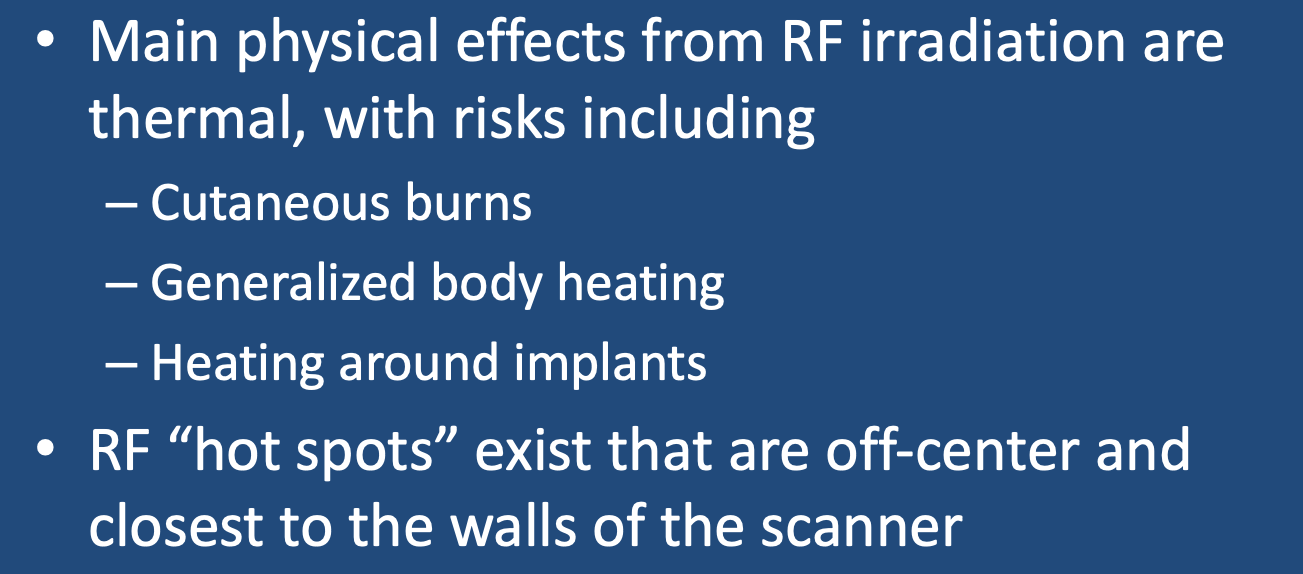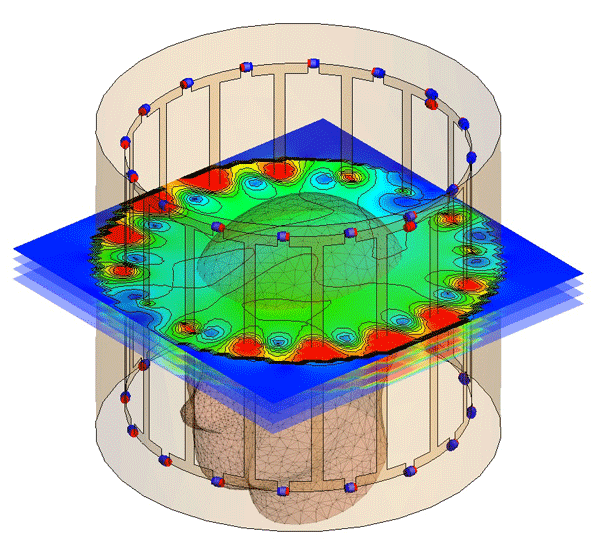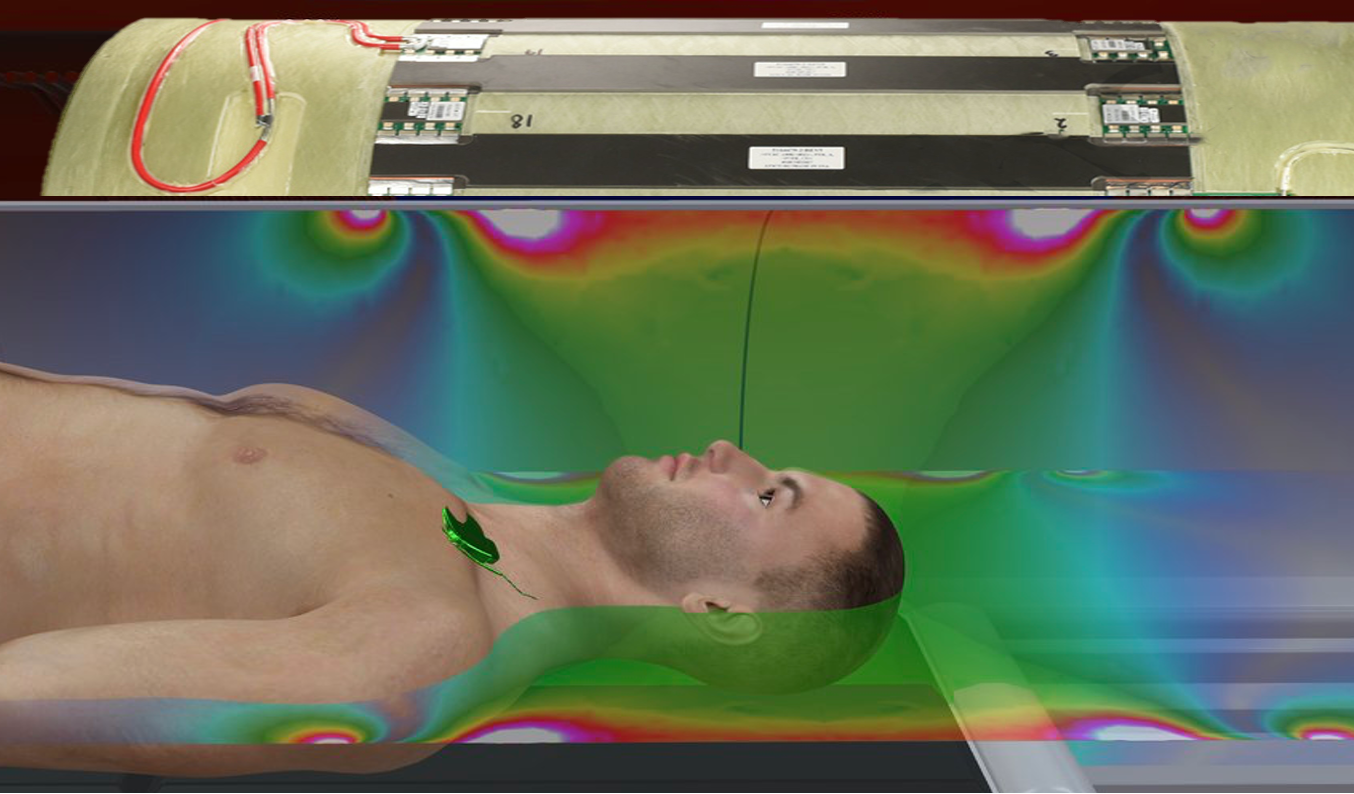|
To generate an MR signal, protons require external stimulation at energies near the resonance frequency. This stimulation comes from an externally positioned radiofrequency (RF) transmit coil. The most common RF-coil design for 3.0T and below is the so-called birdcage coil, a cylindrical structure with multiple rungs. Details about birdcage coil design can be found at this special webpage.
Although local transmit RF-coils may be used for head, knee, and small-parts imaging, the bulk of RF transmission for MRI is performed by birdcage-style "body coils" located immediately beneath the plastic walls of the scanner. |
Standard RF-transmit body coils are only about 50 cm in length and thus do not extend the entire length of the scanner bore (which may be up to 100 cm long). They are positioned to straddle magnet isocenter and produce strong, uniform excitation within this region. Transmitted power dies out significantly as one moves away from isocenter. For most body coils RF power in the midline is reduced by 50% at z = ±15 cm and by 99% at z = ±30 cm.
Interestingly, and widely unrecognized, is the fact that the RF power can be as much as 3x stronger near the scanner walls in locations immediately adjacent to the coils. Focal "hot spots" are present within a few centimeters of the junction of each birdcage rung. These hot spots repeat around the periphery of the magnet bore according to the number of rungs (e.g. 16-32). A patient whose hand, shoulder, or other body part touches the scanner walls (or comes close in these hot spots) is at increased risk of a cutaneous burn. Likewise, a wire or cable passing though the hot spots may be more likely to acquire an induced electric current.
Transmit-receive coils (e.g. for head and knee) have certain advantages over body transmit coils because their magnetic (B) and electric (E) fields are more confined and have less effect on non-imaged body parts. This is illustrated in the field plots below calculated for a gel-filled ASTM phantom. Of interest is that the E fields are maximal in the center of each rung whereas the B fields are concentrated at the ends.

Calculated electric (E) and magnetic (B) field plots in the coronal plane for the ASTM phantom using head coil and body coil transmission respectively. Note concentration of B fields near the ends of the rungs while E fields are more evenly distributed along the entire rung. (From Nagy et al under CC BY)
As described in detail in the subsequent Q&A's, the dominant biological and safety effect of RF stimulation is tissue heating. This can range from acute cutaneous burns to generalized increase in body temperature to localized heating around implants.
Advanced Discussion (show/hide)»
No supplementary material yet. Check back soon!
References
Gruber B, Froeling M, Leiner T, Klomp DWJ. RF coils: a practical guide for nonphysicists. J Magn Reson Imaging 2018:48:590-604. (Comprehensive modern review)
Kanal E. Standardized approaches to MR safety assessment of patients with implanted devices. Magn Reson Imaging Clin N Am 2020; 28:537-548. [DOI LINK]
Nagy Z, Oliver-Taylor A, Kuehne A, et al. Tx/Rx head coil induces less RF transmit-related heating than body coil in conductive metallic objects outside the active area of the head coil. Front Neurosci 2017; 11:15. [DOI LINK]
Nordbeck P, Fidler F, Weiss I, et al. Spatial distribution of RF-induced E-fields and implant heating in MRI. Magn Reson Med 2008; 60:312-319. [DOI LINK]
Stafford RJ. The physics of magnetic resonance imaging safety. Magn Reson Imaging Clin N Am 2020; 28:517-536. [DOI LINK]
Gruber B, Froeling M, Leiner T, Klomp DWJ. RF coils: a practical guide for nonphysicists. J Magn Reson Imaging 2018:48:590-604. (Comprehensive modern review)
Kanal E. Standardized approaches to MR safety assessment of patients with implanted devices. Magn Reson Imaging Clin N Am 2020; 28:537-548. [DOI LINK]
Nagy Z, Oliver-Taylor A, Kuehne A, et al. Tx/Rx head coil induces less RF transmit-related heating than body coil in conductive metallic objects outside the active area of the head coil. Front Neurosci 2017; 11:15. [DOI LINK]
Nordbeck P, Fidler F, Weiss I, et al. Spatial distribution of RF-induced E-fields and implant heating in MRI. Magn Reson Med 2008; 60:312-319. [DOI LINK]
Stafford RJ. The physics of magnetic resonance imaging safety. Magn Reson Imaging Clin N Am 2020; 28:517-536. [DOI LINK]
Related Questions
Is it safe to live under power lines, use a cell phone, or sleep under an electric blanket at night?
How do radiofrequency fields affect biological tissues?
What is SAR?
What is meant by the term "operating mode" of an MR scanner?
Is it safe to live under power lines, use a cell phone, or sleep under an electric blanket at night?
How do radiofrequency fields affect biological tissues?
What is SAR?
What is meant by the term "operating mode" of an MR scanner?


